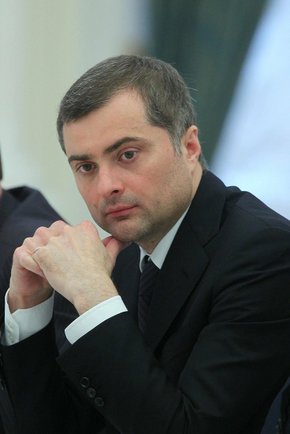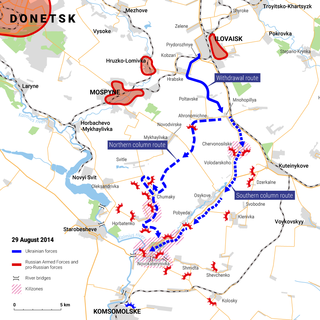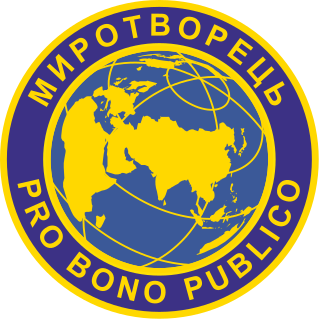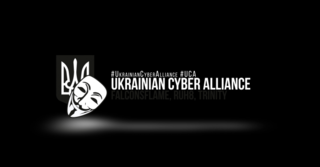
Vladislav Yuryevich Surkov is a Russian politician and businessman. He was First Deputy Chief of the Russian Presidential Administration from 1999 to 2011, during which time he was often viewed as the main ideologist of the Kremlin who proposed and implemented the concept of sovereign democracy in Russia. From December 2011 until May 2013, Surkov served as the Russian Federation's Deputy Prime Minister. After his resignation, Surkov returned to the Presidential Executive Office and became a personal adviser of Vladimir Putin on relationships with Abkhazia, South Ossetia and Ukraine. He was removed from this duty by presidential order in February 2020.

The Russo-Ukrainian War is an ongoing international conflict between Russia and Ukraine, which began in February 2014. Following Ukraine's Revolution of Dignity, Russia annexed Crimea from Ukraine and supported pro-Russian separatists fighting the Ukrainian military in the Donbas war. The first eight years of conflict also included naval incidents, cyberwarfare, and heightened political tensions. In February 2022, Russia launched a full-scale invasion of Ukraine and began occupying more of the country.

The Battle of Ilovaisk started on 7 August 2014, when the Armed Forces of Ukraine and pro-Ukrainian paramilitaries began a series of attempts to capture the city of Ilovaisk from pro-Russian insurgents affiliated with the Donetsk People's Republic (DPR) and detachments of the Russian Armed Forces. Although Ukrainian forces were able to enter the city on 18 August, they were encircled between 24 and 26 August by overwhelming Russian military forces that crossed the border, joining the battle. After days of encirclement, Ukrainian forces rejected the DPR's proposal to open a humanitarian corridor on the condition that they abandon their armored vehicles and ammunition, and on the morning of 29 August 2014 began to leave Ilovaisk with their weapons. The Russian side opened fire on the evacuating Ukrainian soldiers, many of whom died whilst trying to escape.

Anti-Terrorist Operation Zone, or ATO zone, was a term used by the media, publicity, the government of Ukraine, and the OSCE and other foreign institutions to identify Ukrainian territory of the Donetsk and Luhansk regions (oblasts) under the control of Russian military forces and pro-Russian separatists. A significant part of ATO zone is considered temporarily occupied territory of Ukraine.

The 10th Mountain Assault Brigade "Edelweiss" is a specialized unit of the Ukrainian Ground Forces, specifically trained for mountain warfare operations. Based in Kolomyia and part of Operational Command West, the brigade has a history of defending their country in various conflicts, including the war in Donbas in 2016 and the Russian invasion of Ukraine in 2022. During these conflicts, the brigade, defended Marinka, Popasna, Mariupol and Bakhmut.

Myrotvorets or Mirotvorets is a Ukrainian Kyiv-based website that publishes a running list, and sometimes personal information, of people who are considered by authors of the website to be "enemies of Ukraine", or, as the website itself states, "whose actions have signs of crimes against the national security of Ukraine, peace, human security, and the international law". The website was launched in December 2014 by Ukrainian politician and activist Georgy Tuka. The publishing of personal information on the site has been criticized by human rights organizations.

The Democratic National Committee cyber attacks took place in 2015 and 2016, in which two groups of Russian computer hackers infiltrated the Democratic National Committee (DNC) computer network, leading to a data breach. Cybersecurity experts, as well as the U.S. government, determined that the cyberespionage was the work of Russian intelligence agencies.

DCLeaks was a website that was established in June 2016. It was responsible for publishing leaks of emails belonging to multiple prominent figures in the United States government and military. Cybersecurity research firms determined the site is a front for the Russian cyber-espionage group Fancy Bear. On July 13, 2018, an indictment was made against 12 Russian GRU military officers; it alleged that DCLeaks is part of a Russian military operation to interfere in the 2016 U.S. presidential election.

In October 2016, Ukrainian hacker group CyberHunta leaked over a gigabyte of emails and other documents alleged to belong to Russian political operative and senior Kremlin official Vladislav Surkov. Known as Russia's "grey cardinal", Surkov served as a political adviser to President Vladimir Putin in the conflict in eastern Ukraine and is the architect of Russia's ideology of sovereign democracy.

The 61st Marine Brigade is a formation of the Russian Naval Infantry. It is part of the Northern Fleet Naval Infantry and Coastal Defence Force. The brigade is based in the Sputnik military settlement, located in Murmansk Oblast. Some sources consider it one of the best trained and most combat experienced units of the Russian military.

This is a timeline of events related to Russian interference in the 2016 United States elections.

This is a timeline of events related to Russian interference in the 2016 United States elections, sorted by topics. It also includes events described in investigations into the many suspicious links between Trump associates and Russian officials and spies. Those investigations continued in 2017, the first and second halves of 2018, and 2019, largely as parts of the Crossfire Hurricane FBI investigation, the Special Counsel investigation, multiple ongoing criminal investigations by several State Attorneys General, and the investigation resulting in the Inspector General report on FBI and DOJ actions in the 2016 election.

This is a timeline of events related to Russian interference in the 2016 United States elections.

Cyberwarfare is a component of the confrontation between Russia and Ukraine since the Revolution of Dignity in 2013-2014. While the first attacks on information systems of private enterprises and state institutions of Ukraine were recorded during mass protests in 2013, Russian cyberweapon Uroburos had been around since 2005. Russian cyberwarfare continued with the 2015 Ukraine power grid hack at Christmas 2015 and again in 2016, paralysis of the State Treasury of Ukraine in December 2016, a Mass hacker supply-chain attack in June 2017 and attacks on Ukrainian government websites in January 2022.

The Ukrainian Cyber Alliance is a community of Ukrainian cyber activists from various cities in Ukraine and around the world. The alliance emerged in the spring of 2016 from the merger of two cyber activists, FalconsFlame and Trinity, and was later joined by the group RUH8 and individual cyber activists from the CyberHunta group. The hacktivists united to counter Russian aggression in Ukraine.
The Conflict Intelligence Team (CIT) is an independent investigative organisation originating from Russia that conducts open-source investigation of events taking place during armed conflicts, in particular, the actions of Russian troops in Ukraine, Syria, Libya and Central African Republic. Together with Bellingcat and InformNapalm, it is one of the largest such groups that emerged during the Russo-Ukrainian War.
Anonymous, a decentralized international activist and hacktivist collective, has conducted numerous cyber-operations against Russia since February 2022 when the 2022 Russian invasion of Ukraine began.
KibOrg is a project of journalists and IT professionals who have united under the name of legendary cyborgs to fight the aggressor in the information space. The project was founded in early 2022. The only public member to date is journalist Maksym Dudchenko.











